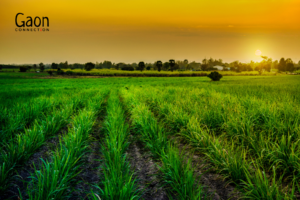Kedia (Jamui), Bihar
Not so long ago, weeding their chemical-sprayed fields would cause painful boils on the hands of women in Kedia village. Often, with pus filled blisters, they continued working, in the fields and at home as they fed firewood into their mud chulhas to prepare meals. Their children ate food made of the produce sprayed with chemicals and fertilisers and fell ill often, putting an added strain on the families’ already struggling existence.
Not any more.
“Our lives are transformed. Bleeding and blistered hands and racking coughs have been replaced with laughter and good health. We also have enough money for our children’s education and to meet our emergency needs,” Bindu Devi, an organic farmer in Kedia told Gaon Connection.
“Raasaynik kheti chor kar gobar ki khaad ki kheti ne hamari zindagi khushaal bana di,” she added with a shy smile [Quitting chemical farming and adopting cowdung-based organic farming has transformed our lives].
Kedia village in Jamui district of Bihar, over 170 kilometres southeast of the state capital Patna, has made it to the organic farming map of India, and is celebrated as the state’s first ‘organic’ village. Half the families in this village of total 100 households have switched to organic cultivation. NGOs, government agencies and officials from different states have been visiting Kedia to learn from its transition from chemical farming to organic farming. Plans are afoot to implement the ‘Kedia model’ of organic farming in other villages of Bihar.
However, amid the celebrations, what often gets overlooked is the contribution of Kedia’s women to eco-friendly agriculture. As this village in south Bihar went organic, it had a direct and positive impact on the lives of the rural women.
“We women collect the dung and urine of our cows, make khana banane wali (cooking) gas from it and also use cowdung in the fields. The vermi khad (vermicompost) gives us a good crop, the food tastes better, our children do not fall sick so often, and we have savings too,” Kanti Devi, who farms her three bigha land and has six cows, told Gaon Connection.
Towards an organic village
The journey towards organic farming in Kedia began in 2014. Ishteyaque Ahmed, the then Senior Food for Life Campaigner at Greenpeace India, was instrumental in raising awareness among the local population about the ill-effects of using chemicals and fertilisers in the fields and the benefits of switching to organic farming.
The “Bihar Living Soils” campaign, under which Kedia was chosen, was an attempt to reduce dependence on agrochemicals such as chemical fertilisers and pesticides, and bring the soil back to life by rejuvenating soil health and biodiversity, using biomass-based organic supplements.
Also Read: A village in Bihar switches to organic farming, sets an example
“We had a simple aim – to act as a bridge between the government and the rural community, and help the government schemes reach the villagers of Kedia,” Ahmed, who is based in Patna and works as a food for future campaigner, told Gaon Connection. “All the schemes that have been implemented in Kedia, including vermi-composting and cattle-sheds, are all part of the existing government programmes, such as MGNREGA, Swachh Bharat Mission, Jaivik Krishi Yojana, etc,” he added.
More than 250 vermi-beds, 22 biogas plants, 40 wells, 15 cement animal sheds, and 20 ecosan (eco-sanitation) toilets that separate out human excreta and urine at the source have been set up with government assistance and subsidies provided to villagers. The agriculture department offered 50 per cent of subsidy on the total input cost to set up these assets.
“Women of Kedia have played a big role in helping this village adopt organic farming. They are the ones who collect cowdung, take care of the cattle and make vermi-compost,” Santosh Kumar Suman, project coordinator with Greenpeace India, told Gaon Connection. “When we started working here, the village was banjar. Today it is clean and green,” he added.
Daughters of the soil
Most households in Kedia own cattle. Women collect cowdung that is fed into the biogas plant (made locally using Sintex plastic water tanks) and the gas is supplied to the kitchens in the village, whereas the dung left at the bottom of the biogas plant is fed into the vermi-beds located right next to the plant. Earthworms in the vermi-beds convert the dung into rich, organic manure.
“Every day, 25 kilos of gobar and 25 litres of water is added to a biogas plant. The gas that comes out is used to cook food and what is left behind makes vermicompost. All this work is done by the women of Kedia,” said Santosh.
Apart from vermicompost and biogas, village women also make other organic sprays using cow urine such as amritpaani, beejamrit, brahmastra, etc.
“The cowdung is used to make vermicompost whereas the cow urine is used to make amritpani,” Ranju Devi, a resident of Kedia explained to Gaon Connection. “To make amritpani, we mix one kilo gobar, one litre cow urine, one kilo besan (gram flour), one kilo neem leaves, one kilo mango leaves, a handful of soil from under the peepul tree and 250 grams jaggery. This is either sprayed on the crops, or during the rainy season, we release it in the fields. This protects the roots of the crops from pests,” she explained.
Also Read: Non-pesticidal management in agriculture is a win-win for farmers and consumers
Hygiene, health and blister-free hands
“About ten years ago, we added chemicals and pesticides to our crops. We would get phode-phunsi [boils] on our hands. Now we only use vermicompost and do not suffer any such health problems,” Ranju Devi said.
“Also, our cattle were kept in the open and during the rainy season, cowdung mixed with cow urine used to flow all over the village leading to unhygienic conditions and spreading of diseases. Now, we have a pashu-shed [cattle shed], which keeps the surroundings clean and we women are no more covered with dung in the rainy season,” Ranju Devi added. Collection of cowdung and cow urine has also become easier.
“The biggest relief is to our eyes and lungs. Earlier when we cooked on traditional chulhas using cowdung cakes or firewood, our eyes smarted with all that smoke, and our lungs were affected too,” said Bindu Devi. “Our hands smelt of cowdung while we cooked food. But not any more as now we cook on biogas,” she added.
Also Read: The journey from a cycle rickshaw driver to an organic farmer
Financial savings
“Earlier when we were doing rasaynik kheti, we would purchase two bags of chemical fertiliser – urea or DAP – for our paddy and wheat crops. One bag cost twelve hundred rupees,” Poonam Devi, a village resident, told Gaon Connection. “During ropayi, all the money we had was used up. So if our kids asked us for books, we could not buy them at that time. Even if kids fell sick, we avoided taking them to the doctor as we could not afford his fee and medicines,” she recalled.
However, adopting organic farming has changed all this. “Now we use vermicompost and save those twelve hundred per bag on urea and DAP. That money is now better utilised to buy clothes for our kids or spend on their education. Ab tension nahi hota hai [now we have no tension],” Poonam Devi added.
These women are torchbearers and are an inspiration for other women who can take up organic farming and transform their lives, said Santosh Kumar.
Clearly, when a village goes organic, it brings additional cheer to its women.


















